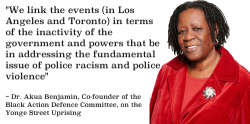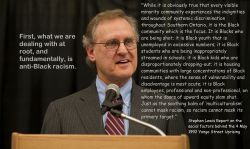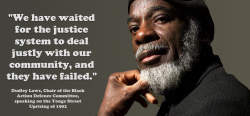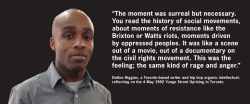Toronto Media Co-op
Local Independent News
Perspectives on Toronto's Yonge Street Uprising of May 4, 1992
A People’s History of the Yonge Street Rebellion
Today marks the 23rd anniversary of the Yonge Street “riot”. I wrote this for a community arts organization a few years ago. From #TDot2Bmore #BlackLivesMatter. Reposting on this May 4th, 2015.
May 4, 1992. Los Angeles was burning and Public Enemy’s Shut ‘Em Down sat atop the rap charts, its opening lyrics delivered in Chuck D’s booming baritone: “I testified/my mama cried/Black people died/When the other man lied”. Four Los Angeles police officers had just been acquitted in the beating of Rodney King. Closer to home, two Peel Region cops implicated in the shooting death of a Black teenager, Michael Wade Lawson, had walked from the courtroom free men. A year prior to the Lawson shooting, Lester Donaldson had been shot by Toronto police as he stood unarmed in his rooming house. And a year following, police had shot and paralyzed 23 year-old Sophia Cook, the third Black person shot by Toronto police in the space of fifteen months.
Then, just days after the King verdict, a 22 year-old Black man by the name of Raymond Lawrence was shot and killed by a Toronto police officer. And so the Black Action Defence Committee (BADC) and its supporters—an organization formed in the wake of the Donaldson shooting—amassed on Yonge Street, just south of Bloor, to protest the shooting death of Lawrence, the decision in the Lawson case, the ongoing police harassment of Toronto’s Black communities, and to stand in solidarity with the LA uprising. The demonstration was initially small, numbering in the hundreds, primarily young Black women and men. But as they began to march, their numbers grew. Aboriginal youth, homeless youth, youth from other racialized communities joined the demonstration following BADC’s lead, chanting “No justice, no peace!”
Read more at: http://simonblack.org/pages/2015/05/04/a-peoples-history-of-the-yonge-street-rebellion/
Toronto’s 1992 Yonge Street Uprising: African Resistance to State/Police Violence
“By what standard of morality can the violence used by a slave to break his chains be considered the same as the violence of a slave master?”
— Dr. Walter Rodney
The May 4, 1992 Yonge Street Uprising was a pivotal moment in the resistance history of African people in the city of Toronto. This rebellion is the first and only one led by Africans against racial and class oppression in this metropolitan area.
It forced the Ontario New Democratic Party (ONDP) government of the day to enact a slew of anti-racist and equity public policy initiatives.
The Yonge Street Uprising shared the same proximate triggering event, as that which tended to inspire rebellions among Africans in the United States. An act of police violence was the immediate cause that led to this uprising in Toronto, and the same factor is at work in the urban insurrections that have broken out in America since the 1960s to today.
The cops are the front-line personnel of the occupation army-like presence, which is the police department in African working-class or racialized communities across Canada and the United States. The writer James Baldwin accurately captures the operational dynamic that makes incidents of police violence, the tripwire for urban rebellion in an article in Esquire in 1960:
“…the only way to police a ghetto is to be oppressive. None of commissioner Kennedy’s policemen, even with the best will in the world, have any way of understanding the lives led by the people they swagger about controlling in two’s and three’s. Their very presence is an insult, and it would be, even if they spent their entire day feeding gumdrops to children. They represent the force of the white world, and that world’s real intentions are, simply, for that world’s criminal profit and ease, to keep the black man (and woman) corralled up here, in… [their] place. The badge, the gun in the holster, and the swinging club make vivid what will happen should… [their] rebellion become overt.”
Read more at: http://pridenews.ca/2015/05/07/torontos-1992-yonge-street-uprising-african-resistance-to-statepolice-violence/
About the poster
The site for the Toronto local of The Media Co-op has been archived and will no longer be updated. Please visit the main Media Co-op website to learn more about the organization.



